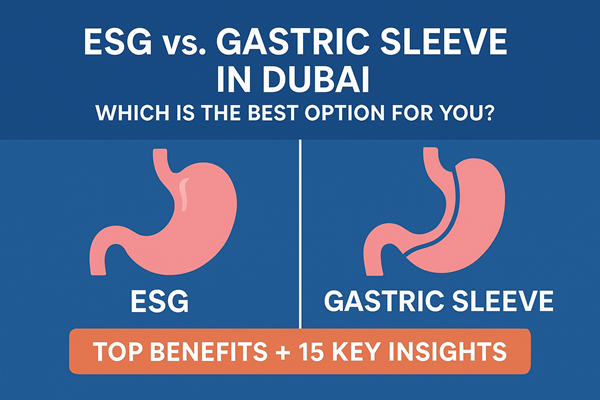
Weight loss surgery has become one of the most reliable solutions for people struggling with obesity and related health issues. In Dubai, two procedures stand out: Endoscopic Sleeve Gastroplasty (ESG) and Gastric Sleeve Surgery. Both methods aim to reduce stomach size, limit food intake, and help individuals lose weight sustainably. But they differ in how they’re performed, their effectiveness, recovery time, and long-term outcomes.
This article explores the pros, cons, and key insights of ESG vs. Gastric Sleeve in Dubai, providing clarity for anyone considering these options.
What is ESG (Endoscopic Sleeve Gastroplasty)?
ESG is a minimally invasive, non-surgical procedure that reduces the stomach size using an endoscope and sutures, without removing any part of the stomach.
How ESG is Performed
A flexible tube with a camera (endoscope) is inserted through the mouth into the stomach.
Specialized sutures are placed inside, shrinking the stomach by about 70%.
The procedure typically lasts 60–90 minutes and doesn’t involve external incisions.
Advantages of ESG
No external cuts or scars.
Faster recovery time—most patients return to daily activities within 3–5 days.
Lower risk of complications compared to surgical procedures.
Reversible and repeatable if needed.
Limitations of ESG
May not achieve the same dramatic weight loss results as surgical options.
Not suitable for patients with very high BMI (usually above 40).
Requires strong commitment to lifestyle and dietary changes.
What is Gastric Sleeve Surgery?
Also known as Sleeve Gastrectomy, this is a surgical procedure that removes about 75–80% of the stomach permanently, leaving a smaller “sleeve-shaped” pouch.
How Gastric Sleeve is Performed
Performed under general anesthesia.
Surgeons make small incisions in the abdomen and use laparoscopic instruments.
The stomach is stapled and a large portion is removed.
Advantages of Gastric Sleeve
Significant weight loss (60–70% of excess weight in 12–18 months).
Reduction in hunger hormones like ghrelin.
Proven long-term success for patients with obesity-related conditions.
Limitations of Gastric Sleeve
Irreversible—once the stomach is removed, it cannot be restored.
Longer recovery time (2–3 weeks).
Higher risks of complications compared to ESG (e.g., leakage, infection).
ESG vs. Gastric Sleeve: Key Differences
| Factor | ESG | Gastric Sleeve |
|---|---|---|
| Approach | Endoscopic, non-surgical | Surgical, laparoscopic |
| Stomach Size Reduction | ~70% | ~75–80% |
| Weight Loss | Moderate (15–20% of body weight in 1 year) | Significant (25–30% in 1 year) |
| Recovery Time | 3–5 days | 2–3 weeks |
| Risks | Low | Moderate–high |
| Reversibility | Yes | No |
| Cost in Dubai | AED 30,000–40,000 | AED 35,000–55,000 |
Who is the Right Candidate for ESG?
Individuals with BMI between 30–40.
Patients seeking a less invasive option.
Those who want a faster recovery with fewer risks.
People who can commit to long-term lifestyle changes.
Who is the Right Candidate for Gastric Sleeve?
Individuals with BMI above 35 (especially with diabetes, hypertension, or sleep apnea).
Patients who need significant weight loss for long-term health.
Those willing to undergo surgery and accept a longer recovery period.
Comparing Lifestyle Impact of ESG and Gastric Sleeve
Both procedures require lifelong commitment to healthy eating, exercise, and regular follow-up appointments. Gastric Sleeve patients may need vitamin supplementation for life, while ESG patients may rely more on dietary discipline since results are less drastic.
ESG vs. Gastric Sleeve Success Stories in Dubai
Patients in Dubai report high satisfaction with both procedures. ESG patients often highlight the quicker recovery and minimal disruption to daily life, while Gastric Sleeve patients share long-term success in resolving obesity-related conditions like type 2 diabetes and hypertension.
Costs and Insurance Coverage in Dubai
ESG: AED 30,000–40,000
Gastric Sleeve: AED 35,000–55,000
Insurance coverage varies. Many providers in Dubai only cover Gastric Sleeve if deemed medically necessary, while ESG is often considered elective. Patients should check with their insurers in advance.
Long-Term Health Benefits of Both Procedures
ESG Benefits: Reduced calorie intake, lower risk of complications, gradual weight loss.
Gastric Sleeve Benefits: Substantial and lasting weight loss, improvement or resolution of obesity-related diseases, enhanced quality of life.
When deciding between ESG and Gastric Sleeve in Dubai, the right choice depends on your health condition, BMI, lifestyle, and long-term goals. ESG is less invasive, safer, and allows quicker recovery, but offers moderate results. Gastric Sleeve is permanent, more effective for severe obesity, but comes with higher risks and longer downtime.
Ultimately, consulting with a bariatric specialist in Dubai is the best way to determine which procedure aligns with your health and weight loss goals.
Frequently Asked Questions
Yes, ESG is generally safer as it’s non-surgical and less invasive. However, Gastric Sleeve offers greater weight loss results.
Yes, ESG can be converted to a surgical option if needed, making it a flexible starting point for many patients.
ESG patients lose about 15–20% of body weight within a year, while Gastric Sleeve patients lose 25–30% or more.
Yes, both procedures require a lifelong diet plan focusing on small portions, protein-rich foods, and limited sugar intake.
For patients with severe obesity, Gastric Sleeve tends to deliver more sustainable long-term results. ESG is ideal for those who want moderate weight loss with less risk.
Gastric Sleeve may be covered if medically necessary, while ESG is usually not covered and considered elective.
